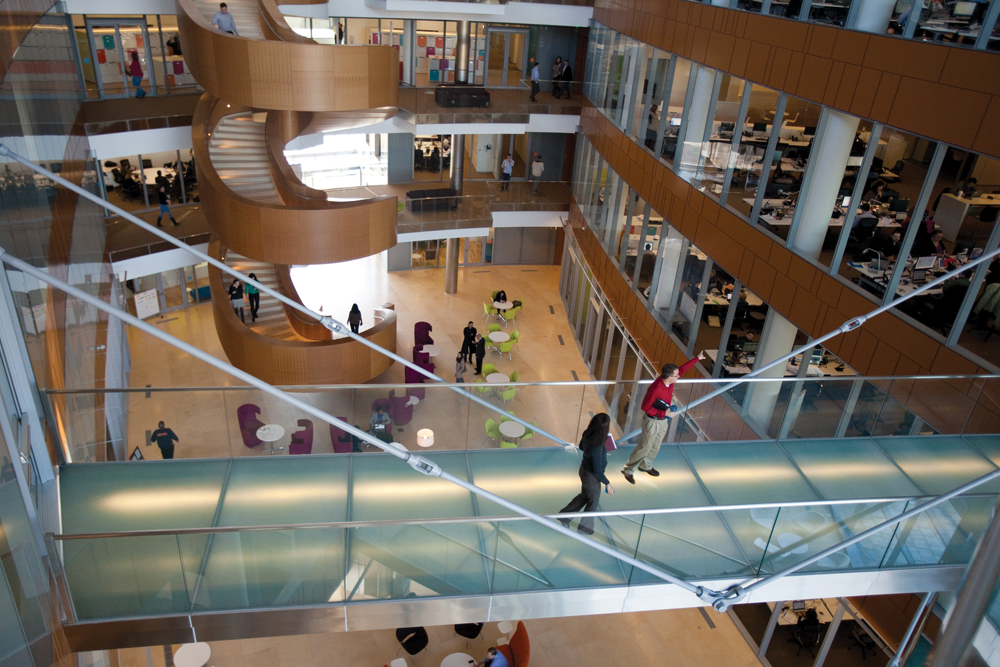Many firms that do office design and construction stayed afloat during the recession with modest projects—fit-outs, renovations, targeted green retrofits. But the sector’s finally heating up.
Commercial Realtors recently reported an increase in annual gross income for the third year in a row (www.BDCnetwork.com/Realtors2013). Jones Lang LaSalle’s latest office forecast pegged more than a dozen metros as being in “a rising phase,” including Austin, Dallas, Boston, Denver, Pittsburgh, Indianapolis, and New York (http://bit.ly/JLLOffice13).
Though speculative projects still lag, corporate HQs and medical office buildings are moving ahead. “The medical office building of the future can accommodate much of what was done in a traditional hospital setting,” says Steve Straus, President of Glumac. “Some of our clients have bold ambitions, including net-zero.”
TOP OFFICE SECTOR ARCHITECTURE FIRMS
2012 Office Revenue ($)1 Gensler $462,700,5002 HOK $128,726,0003 Perkins+Will $107,951,6724 NBBJ $64,002,0005 Stantec $62,500,2366 PageSoutherlandPage $43,190,0007 Heery International $39,443,9318 Kohn Pedersen Fox Associates $38,081,0009 RTKL Associates $37,474,00010 Hammel, Green and Abrahamson $37,307,000
TOP OFFICE SECTOR ENGINEERING FIRMS
2012 Office Revenue ($)1 AECOM Technology Corp. $830,320,0002 Parsons Brinckerhoff $146,400,0003 Jacobs Engineering Group $95,180,0004 Burns & McDonnell $82,020,0005 Thornton Tomasetti $50,861,4676 Michael Baker Jr. $50,720,0007 WSP USA $48,500,1628 Arup $32,355,6079 Buro Happold Consulting Engineers $28,720,00010 AKF Group $26,917,000
TOP OFFICE SECTOR CONSTRUCTION FIRMS
2012 Office Revenue ($)1 Turner Corporation, The $2,195,790,0002 Structure Tone $1,435,332,0003 PCL Construction Enterprises $1,409,212,7274 Clark Group $974,974,0665 Skanska USA $847,106,2426 Balfour Beatty $792,915,5767 Gilbane $690,915,0008 JE Dunn Construction $613,825,5639 James G Davis Construction $575,006,00010 HITT Contracting $535,524,009
On the West Coast, tech firms are creating eye-popping campuses, including NBBJ projects for Amazon (Seattle, 3.3 million sf); Samsung (San Jose, 1.1 million sf, with Arup); and Google (Mountain View, Calif., 1 million sf). Facebook tapped Frank Gehry to design its 420,000-sf Facebook West in Menlo Park, Calif., and Foster + Partners is designing Apple’s 2.8 million-sf, net-zero Campus 2 in Cupertino (to be built by DPR-Skanska.)
Bleeding-edge companies seek the latest in social engineering and sustainability, but they’re not alone in believing that generational and technological trends justify a reboot in office design. “The relevance of ‘the office’ is in question,” says Steve Hart, Director of Interior Design at Heery. “Why are you even in an office? We believe the office needs to help individuals feel connected to the company and support a common sense of purpose.”
Read BD+C's full Giants 300 Report
Related Stories
| Nov 2, 2010
Energy Analysis No Longer a Luxury
Back in the halcyon days of 2006, energy analysis of building design and performance was a luxury. Sure, many forward-thinking AEC firms ran their designs through services such as Autodesk’s Green Building Studio and IES’s Virtual Environment, and some facility managers used Honeywell’s Energy Manager and other monitoring software. Today, however, knowing exactly how much energy your building will produce and use is survival of the fittest as energy costs and green design requirements demand precision.
| Nov 2, 2010
Yudelson: ‘If It Doesn’t Perform, It Can’t Be Green’
Jerry Yudelson, prolific author and veteran green building expert, challenges Building Teams to think big when it comes to controlling energy use and reducing carbon emissions in buildings.
| Nov 2, 2010
Historic changes to commercial building energy codes drive energy efficiency, emissions reductions
Revisions to the commercial section of the 2012 International Energy Conservation Code (IECC) represent the largest single-step efficiency increase in the history of the national, model energy. The changes mean that new and renovated buildings constructed in jurisdictions that follow the 2012 IECC will use 30% less energy than those built to current standards.
| Nov 1, 2010
Sustainable, mixed-income housing to revitalize community
The $41 million Arlington Grove mixed-use development in St. Louis is viewed as a major step in revitalizing the community. Developed by McCormack Baron Salazar with KAI Design & Build (architect, MEP, GC), the project will add 112 new and renovated mixed-income rental units (market rate, low-income, and public housing) totaling 162,000 sf, plus 5,000 sf of commercial/retail space.
| Nov 1, 2010
John Pearce: First thing I tell designers: Do your homework!
John Pearce, FAIA, University Architect at Duke University, Durham, N.C., tells BD+C’s Robert Cassidy about the school’s construction plans and sustainability efforts, how to land work at Duke, and why he’s proceeding with caution when it comes to BIM.
| Nov 1, 2010
Vancouver’s former Olympic Village shoots for Gold
The first tenants of the Millennium Water development in Vancouver, B.C., were Olympic athletes competing in the 2010 Winter Games. Now the former Olympic Village, located on a 17-acre brownfield site, is being transformed into a residential neighborhood targeting LEED ND Gold. The buildings are expected to consume 30-70% less energy than comparable structures.
| Oct 27, 2010
Grid-neutral education complex to serve students, community
MVE Institutional designed the Downtown Educational Complex in Oakland, Calif., to serve as an educational facility, community center, and grid-neutral green building. The 123,000-sf complex, now under construction on a 5.5-acre site in the city’s Lake Merritt neighborhood, will be built in two phases, the first expected to be completed in spring 2012 and the second in fall 2014.
| Oct 21, 2010
GSA confirms new LEED Gold requirement
The General Services Administration has increased its sustainability requirements and now mandates LEED Gold for its projects.
| Oct 18, 2010
World’s first zero-carbon city on track in Abu Dhabi
Masdar City, the world’s only zero-carbon city, is on track to be built in Abu Dhabi, with completion expected as early as 2020. Foster + Partners developed the $22 billion city’s master plan, with Adrian Smith + Gordon Gill Architecture, Aedas, and Lava Architects designing buildings for the project’s first phase, which is on track to be ready for occupancy by 2015.














